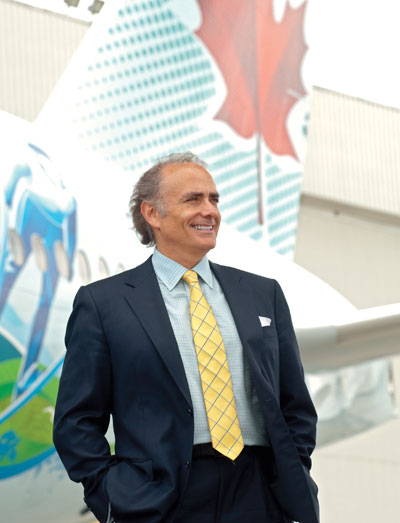
Features
Operations
Alternate Approach: Playing the alliance game
Air Canada chief executive Calin Rovinescu is stepping into the position of chair of the Star Alliance executive board at the same time cracks are forming along the traditional airline alliance model.
January 4, 2013 By David Carr
Air Canada chief executive Calin Rovinescu is stepping into the position of chair of the Star Alliance executive board at the same time cracks are forming along the traditional airline alliance model. A near rupture occurred at rival oneworld last September when Australia’s Qantas Airways, a founding member, announced a new partnership with unaligned Emirates, and cancellation of a 17-year business agreement with fellow oneworld partner British Airways on routes between Australia and the U.K.
 |
|
| You have benefits around the margins, but unless you have common ownership, there are going to be different perspectives. Photo: Air Canada
|
“This deal will have a fairly seismic shift on the alliances,” Tim Clark, Emirates president and chief alliance sceptic told the Wall Street Journal.
Alliances were formed in the 1990s to capture connecting passengers by building seamless global networks, share value-added perks such as premium lounges and frequent flyer points, and reduce operating costs by leveraging procurement for everything from cabin interiors to aircraft orders – all to varied degrees of success.
The world’s three global tie-ups – Star Alliance, oneworld and SkyTeam – fly approximately 46 per cent of the industry’s global seat capacity. Of the three, Star Alliance, which was first out of the gate with Air Canada, United Airlines and Lufthansa as founding partners, is the dominant partnership with approximately 25 per cent of global capacity and a level of integration that has left oneworld, at least, circling.
But leveraging costs has not panned out. “Those objectives work well on paper and less so in terms of execution,” Air Canada’s Rovinescu told Wings. “So as long as you have separate management with separate opinions whether it has to do with a seat or the toilet paper you are going to have on an airplane, it is going to be really tough to achieve. You have benefits around the margins, but unless you have common ownership there are going to be different perspectives.”
Star has had more success cementing a global network. There are signs, however, that airlines might be shifting toward bilateral rather than group partnerships – WestJet’s preferred business model, and one recently evidenced by the Emirates-Qantas tie-up.
Here, Qantas is essentially outsourcing the flying of all so-called Kangaroo routes to Europe, with the exception of London, to Emirates through its spectacular Dubai hub. The two airlines will operate up to 14 daily flights between Australia and Dubai. “This is the most significant partnership the Qantas Group has ever formed with another airline, moving past the traditional alliance model to a new level,” Alan Joyce, Qantas chief executive said.
Even so, Qantas is insisting it will remain in the oneworld family, although it is difficult to see how over the long term – especially as it markets the 10-year arrangement with Emirates as “the world’s leading airline partnership,” and now that Qatar Airways, one of Emirates three Gulf rivals, has joined oneworld.
Qantas is not the only airline to step outside the club and make new friends, although none to that extent just yet. Air Canada recently signed an interline agreement with Ireland’s Aer Lingus, a former oneworld member, that is expected to grow into a full code sharing relationship later this year. Unaligned Etihad Airways is linking up with Air France, a founding member of SkyTeam, and is encouraging Air Berlin, its German partner in oneworld to do the same.
TAM, Brazil’s largest airline is expected to exit Star later this year, the result of a merger with Chile’s LAN, a founding oneworld member, and a judge’s ruling that the combined unit cannot be a member of both. The two airlines will likely maintain separate brands so it is not automatic that TAM will apply for membership in oneworld. Rather, the airline may operate unaligned and negotiate bilateral code shares with Air Canada and other former Star Alliance carriers.
This is not the end of the airline alliance, although they are going to become more fluid as airlines consolidate or partner airlines chase markets where the alliance presence is weak such as Africa and India in the case of Star. Alliances are also only as strong as their weakest partner, suggesting that on some routes travellers are not going to like the connections made for them.
Recent developments may have also finally ended legacy airlines’ mistrust of and hostility to the big three Gulf carriers, at least among some members of oneworld and SkyTeam. Star chief executive Mark Schwab recently told an industry forum in Panama City that he was comfortable keeping Gulf carriers out of the alliance. It’s a puzzling position to take and echoes the attitude of American automakers to Japanese imports in the 1970s, or the tin ear record labels first turned to the digital revolution.
David Carr is a Wings writer and columnist.